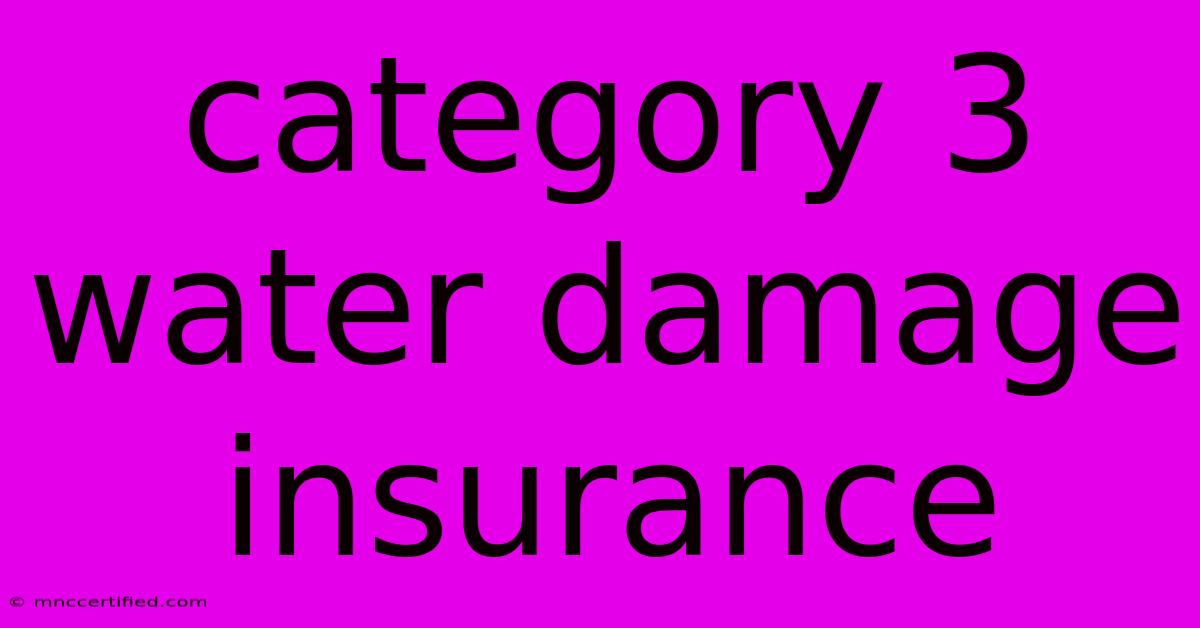Category 3 Water Damage Insurance

Table of Contents
Understanding Category 3 Water Damage Insurance
Water damage is a homeowner's worst nightmare, and understanding your insurance coverage is crucial. This article delves into Category 3 water damage, explaining what it entails, how it differs from other categories, and what your insurance policy likely covers (and doesn't). We'll also explore how to file a claim and what steps you can take to prevent future water damage.
What is Category 3 Water Damage?
Category 3 water damage refers to water contamination that poses significant health risks. Unlike Categories 1 and 2, which involve relatively clean water, Category 3 water is heavily contaminated with sewage, bacteria, or other harmful substances. This contamination necessitates extensive remediation and often involves specialized equipment and procedures. Think overflowing sewage lines, backed-up sump pumps contaminated with wastewater, or floodwater carrying pollutants.
Key characteristics of Category 3 water damage:
- Significant contamination: The water source is visibly dirty and contains harmful bacteria, viruses, or other pathogens.
- Health risks: Exposure can cause serious illness.
- Extensive remediation: Professional cleaning and sanitation are essential, often requiring specialized equipment and techniques.
- Higher insurance claim costs: The remediation process is more complex and expensive than for lower categories.
How Category 3 Differs from Categories 1 & 2
Understanding the differences between water damage categories is critical for effective insurance claims.
Category 1: Clean Water
This involves water from sources like a clean overflowing toilet bowl, a broken water supply line, or a leaky roof before it’s had a chance to become contaminated. Remediation is typically less extensive.
Category 2: Grey Water
Grey water, like that from a washing machine overflow or a dishwasher leak, contains some level of contamination and requires more rigorous cleaning than Category 1. While not as hazardous as Category 3, it still necessitates professional attention.
Category 3: Black Water
Category 3, or "black water," is the most dangerous. This severely contaminated water presents a serious health threat and demands immediate professional remediation.
What Your Insurance Policy Covers (and Doesn't)
Most homeowners insurance policies cover water damage, but the extent of coverage depends on the cause and the category of water damage. Your policy will likely cover Category 3 water damage if it's caused by a covered peril, such as a burst pipe, overflowing toilet (if the overflow was due to a malfunctioning system, not a blockage caused by the homeowner), or a sudden and accidental sewer backup. However, certain exclusions may apply:
- Flood damage: Flood insurance is typically a separate policy. While some policies might offer limited sewer backup coverage, significant flood damage usually requires a National Flood Insurance Program (NFIP) policy.
- Neglect or intentional damage: Damage caused by negligence or deliberate actions is usually excluded.
- Specific exclusions: Review your policy carefully for any specific exclusions related to water damage.
Contact your insurance provider immediately to report the damage and start the claims process. They'll need to assess the situation to determine the extent of the coverage.
Filing a Category 3 Water Damage Claim
Filing a claim for Category 3 water damage requires careful documentation and prompt action.
- Document the damage: Take detailed photographs and videos of the affected areas.
- Contact your insurance company: Report the damage immediately.
- Work with a professional remediation company: Your insurance company might recommend or approve a specific contractor.
- Keep records: Maintain meticulous records of all communication, invoices, and receipts related to the claim.
- Be patient: The claims process can take time, especially for extensive damage.
Preventing Future Category 3 Water Damage
Proactive measures can significantly reduce the risk of future Category 3 water damage:
- Regular maintenance: Inspect plumbing regularly for leaks and cracks.
- Sewer line maintenance: Schedule regular sewer line inspections and cleaning.
- Sump pump maintenance: Regularly check and maintain your sump pump.
- Proper ventilation: Ensure adequate ventilation in bathrooms and other areas prone to moisture.
Understanding Category 3 water damage and your insurance coverage is essential for protecting your home and finances. Remember to review your policy thoroughly, document everything meticulously, and act swiftly in case of water damage. Prevention is always better than cure, so regular maintenance is key to avoiding costly and hazardous water damage situations.

Thank you for visiting our website wich cover about Category 3 Water Damage Insurance. We hope the information provided has been useful to you. Feel free to contact us if you have any questions or need further assistance. See you next time and dont miss to bookmark.
Featured Posts
-
Pakistan Vs Australia 3rd T20 I Result
Nov 19, 2024
-
Croatia Vs Portugal Live Score And Updates
Nov 19, 2024
-
Gmail Shielded Email Alias Creation
Nov 19, 2024
-
One Dies Dozens Sick From Organic Carrots
Nov 19, 2024
-
Utah Thanksgiving Dinner Where To Go
Nov 19, 2024